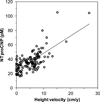Amino-terminal propeptide of C-type natriuretic peptide (NTproCNP) predicts height velocity in healthy children
- PMID: 22435455
- PMCID: PMC3466812
- DOI: 10.1111/j.1365-2265.2012.04392.x
Amino-terminal propeptide of C-type natriuretic peptide (NTproCNP) predicts height velocity in healthy children
Abstract
Objective: C-type natriuretic peptide (CNP) is a paracrine regulatory factor of the growth plate and plays a key role in endochondral growth. Its amino-terminal propeptide (NTproCNP) is an equimolar product of CNP biosynthesis and is easily measured in plasma. Preliminary studies suggest that NTproCNP levels correlate with height velocity in sheep and children. The objectives of the study were to correlate NTproCNP levels with height velocity and to define the reference range for plasma CNP and NTproCNP across childhood.
Design: This was a prospective, cross-sectional, observational study of healthy children.
Patients: Participants were 258 healthy children between 2 months and 20 years of age.
Measurements: Anthropometrics were obtained and CNP and NTproCNP levels were determined by radioimmunoassay.
Results: For both sexes, CNP and NTproCNP levels were high in infancy, lower in early childhood, rising during puberty, then falling to low adult levels. Levels of NTproCNP peaked at 14·1 years in boys and 11·9 years in girls, coincident with the age of peak height velocity. Levels of NTproCNP varied with pubertal status, peaking at genital Tanner stage IV in boys and III in girls. There was a highly significant correlation between NTproCNP and height velocity.
Conclusions: C-type natriuretic peptide plays an integral role in endochondral growth. We show here that CNP synthesis (as measured by NTproCNP levels in plasma) is closely related to linear growth in healthy children at all ages. We propose NTproCNP as a biomarker of linear growth.
© 2012 Blackwell Publishing Ltd.
Figures




References
-
- Yasoda A, Komatsu Y, Chusho H, et al. Overexpression of CNP in chondrocytes rescues achondroplasia through a MAPK-dependent pathway. Nat Med. 2004;10:80–86. - PubMed
-
- Bocciardi R, Giorda R, Buttgereit J, et al. Overexpression of the C-type natriuretic peptide (CNP) is associated with overgrowth and bone anomalies in an individual with balanced t(2;7) translocation. Hum Mutat. 2007;28:724–731. - PubMed
Publication types
MeSH terms
Substances
Grants and funding
LinkOut - more resources
Full Text Sources
Other Literature Sources
Medical

